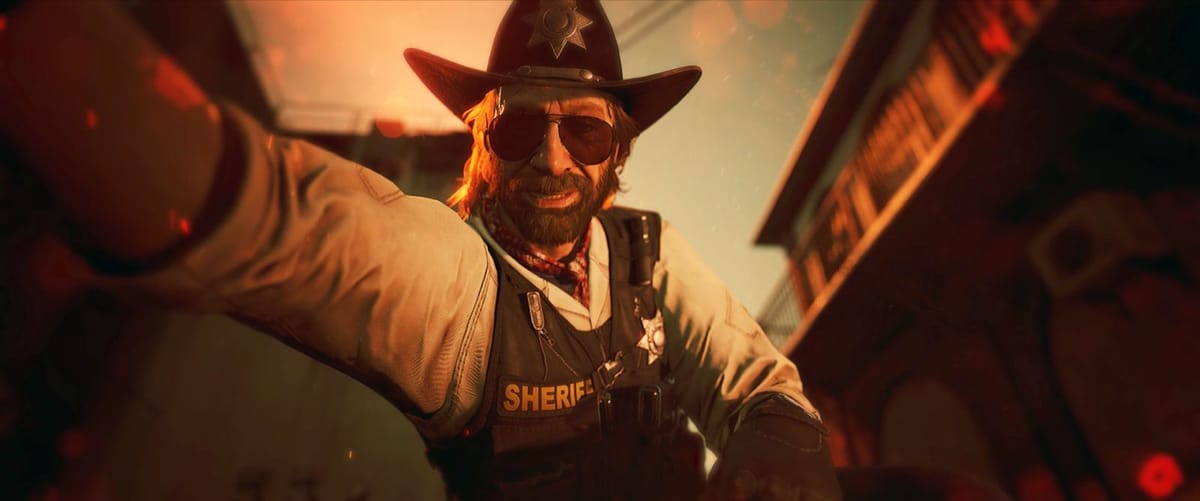
When I first saw the trailer for Crime Boss: Rockay City I knew I needed to play it. Chuck Norris’s hand grazed a basketball, sending it into high orbit, striking a satellite, and then returning to earth for the sickest three point shot the world has ever seen. All while he was performing pushups, causing the earth to tremor. The trailer prepared me for a fun, campy romp with a cops vs robbers theme, taking place in a Floridian city in the 90s: Rockay City. However, Crime Boss fails to deliver said camp. In fact, what I got was a game that tries to juggle interesting concepts, but fails to fully flesh any of them out.
The story of Crime Boss is simple in premise, yet confusing in execution. You play as Travis Baker, (played by Michael Madsen) a small-time criminal trying to make it out of a heist gone wrong. I would say that it’s fitting the game starts off with your character dazed from a flashbang, because the following sequence of events are disorienting. You escape (or die) and set up your crew and minor drug trade. Your goal is to supply The King of Rockay City with drugs for his party, thus gaining his blessing to sell on his turf.
However, before The King or any of his lackeys can even get a word in, they all die in an explosion at said party. Now there’s a new objective: Become the Florida King. I can get behind that, but the rapid-fire tempo of these cutscenes and opening vignettes make the player feel as though they’re being spun around. I felt like I was missing cutscenes or context at times. To add, the voice acting can be pretty shoddy, like the voice actors weren’t actually interacting, which adds to the confusion.

It makes sense that the story isn’t too in depth in the cutscenes because Crime Boss has roguelike elements, and restarting is common. Having to sit through watching the same story beats over and over again in various runs would be annoying. To add, the story has very simple characters, with common phrases and archetypes like “The King”. Everyone knows what a king is, it doesn’t need special explanation or introduction. It’s perfect for a placeholder character who’s meant to die in an explosion within the first ten minutes.
The entirety of your crew is as archetypal as it is star studded. Your lieutenant, Touchdown, is a violent guy who loves fighting and constantly shouts football references. He even carries a football around everywhere he goes. He’s played by Michael Rooker. Narassa is the analyst, he’s calm, collected, intelligent, and played by Damion Poiter. He’ll be the one praising or admonishing you during your missions. Next is Casey, she takes care of your stash and manages your territory’s fiscal aspects, and she’s played by Kim Basinger. Finally, there’s Gloves, the dirty cop who helps you out, played by Danny Glover. The archetypes work well here. It’s not meant to be a genius plot, it’s meant to be a catalyst for the gameplay. So, how does that go?
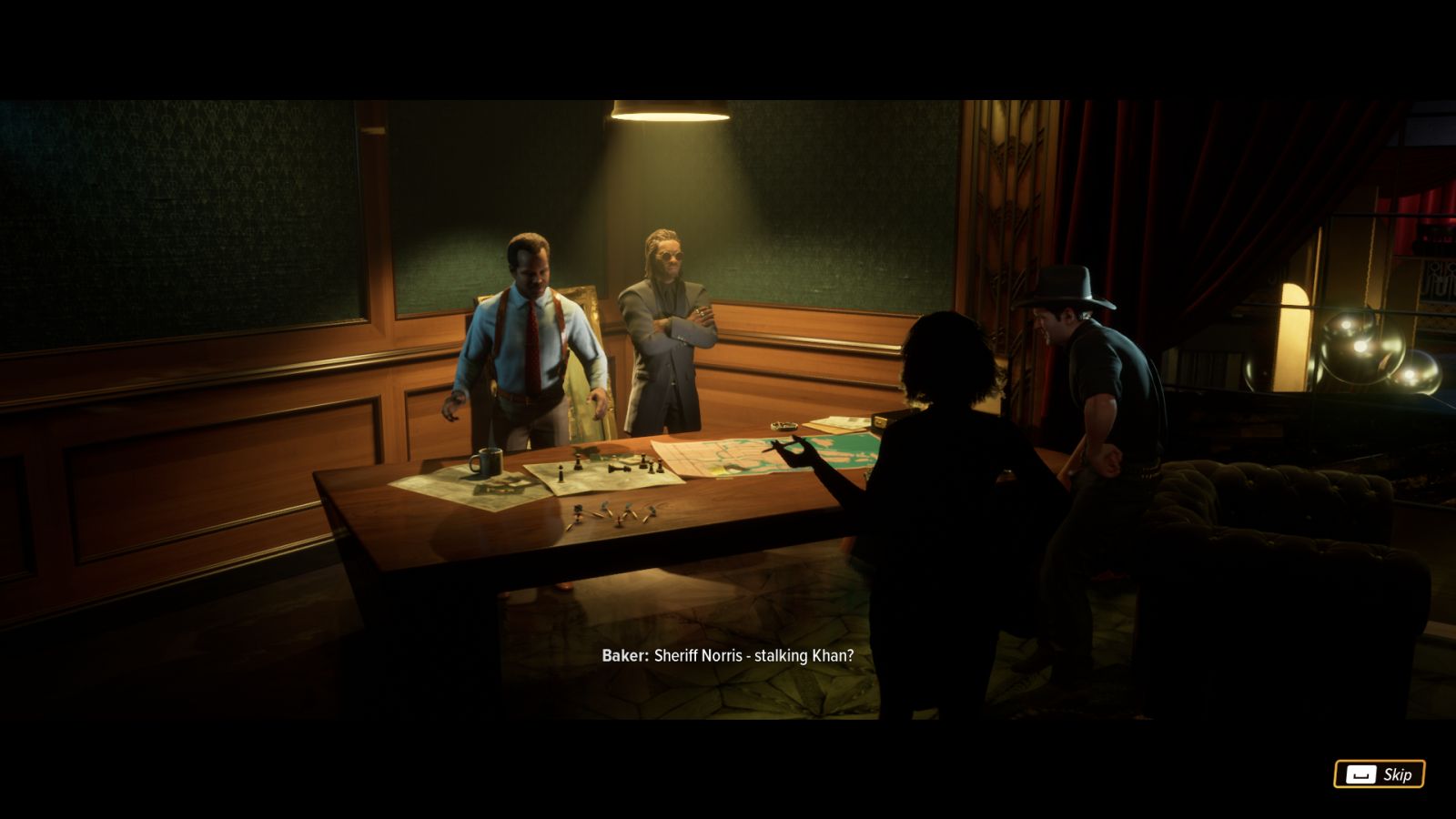
In order to complete your new goal of becoming The King of Rockay City, you need money, and lots of it. You can gain cash from completing missions, capturing and controlling territories, and selling your loot. There are various missions such as the basic capers, like robbing a poorly guarded warehouse, or stealing from a rival gang’s hideout. However, the real meat of the game comes from the heists, like breaking into banks or jewelry stores, and eventually larger scale, more unique heists. One annoying aspect of missions is that you can’t quit to the main menu while in one, you have to quit to desktop.
You assemble a team of up to four crew members for missions, each of whom have traits and hiring costs. Traits can be wonky due to random generation. For example, one had a trait which decreased his mission cut, but gave him another random negative trait, and that trait increased his mission cut. There are other team members who are unique, with plenty of good traits, but their recruitment fee is usually quite pricey. The AI is pretty competent too, and will grab loot bags and take the initiative to bring them back to the escape truck.
One really cool feature is that you can switch between your teammates during missions. Let’s say you have one crew member who’s good at stealth and gives you better mission rewards, and another who’s fast while carrying bags, has decreased weapon sway, and has more health. You could start the heist with the stealthy one, and if events take a bad turn, switch to the character better combat stats. It’s important to note that crew members can only go on one mission per day, so building up your crew is important.

There’s generally an order of operations to ensure your heist doest go south. Avoid the cameras and guards, disable the cameras and guards, subdue any civilians, bag the loot, and get out of there. However, events rarely pan out so well.
Stealth is an incredibly important aspect of this game, but it’s not always consistent, and sometimes you’re forced into combat. The pacify option to subdue enemies straight up doesn’t work sometimes, meaning your mission quickly derails after a security guard tries to play hero. Sometimes guards will start detecting you without even looking at you. If you try to stealth kill a security guard, you gain interest (apparently they immediately notice that the guard alone on the second story is missing). There are only three levels of interest, each of which makes the guards more alert, all culminating in your detection.
When you get into combat, there’s a five star heat system that gradually increases depending on how long you prolong the fight. When the subdue button does work, you can zip tie them, and tell them to move, but captured people take their sweet time while moving. It’s less like they’re tied up by an armed robber who is giving them commands, and more like they’re an edgy teenager and their mom just told them to take out the trash. They will glare at you, and move at a snail’s pace.
To add to the problems, stealth is sometimes impossible, IE three enemies with their backs against a wall facing the objective with no way to take them out silently, so if you don’t have a silenced weapon, you’re out of luck. Stealth kills can also be rather iffy, as I tried to stab one guy in the back, but it didn’t work. That alerted the whole base, and I was killed. Once you finally do get a silenced weapon, the game becomes 10x easier and missions go by faster. It really shows the importance of getting these mechanics balanced right, and ensuring that they’re consistent.
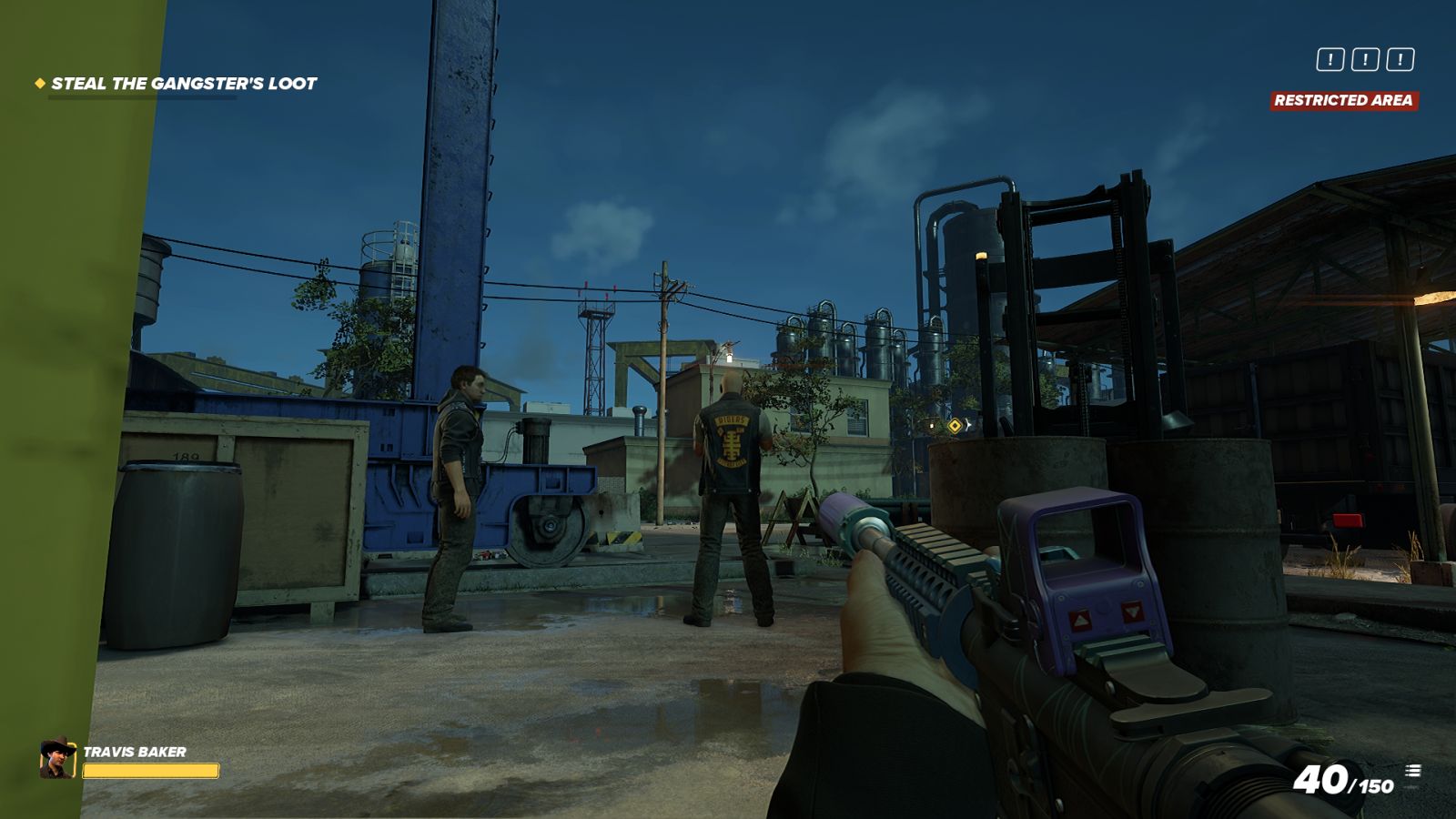
At one point, a bunch of civilians started just walking into the restricted area, thus ruining my stealthy attempt at pilfering the goods. On another mission, the gangsters randomly ignited a gas canister, killing themselves, and alerting the authorities. It seems like a scripted event that happens every other time I play the warehouse map. It’s like the game was forcing me to lose the element of surprise, like it was saying “Woah, wouldn’t it be cool if an action sequence happened now!” This is made worse by the fact that while you’re heisting, Detective Norris is after you, and going guns blazing – especially killing civilians – will hasten his investigation. The further into his investigation he is, the more “Heat” you have, meaning how hard the cops crusade against you.
There are also random events that can happen during a heist, like a gang attack, (which will also ruin your stealth run) or a party outside of a closed mall at night (for some reason), thus increasing your chance of detection. Other random events occur outside of missions, such as losing or gaining money, or having an elite crew member offer to join you.
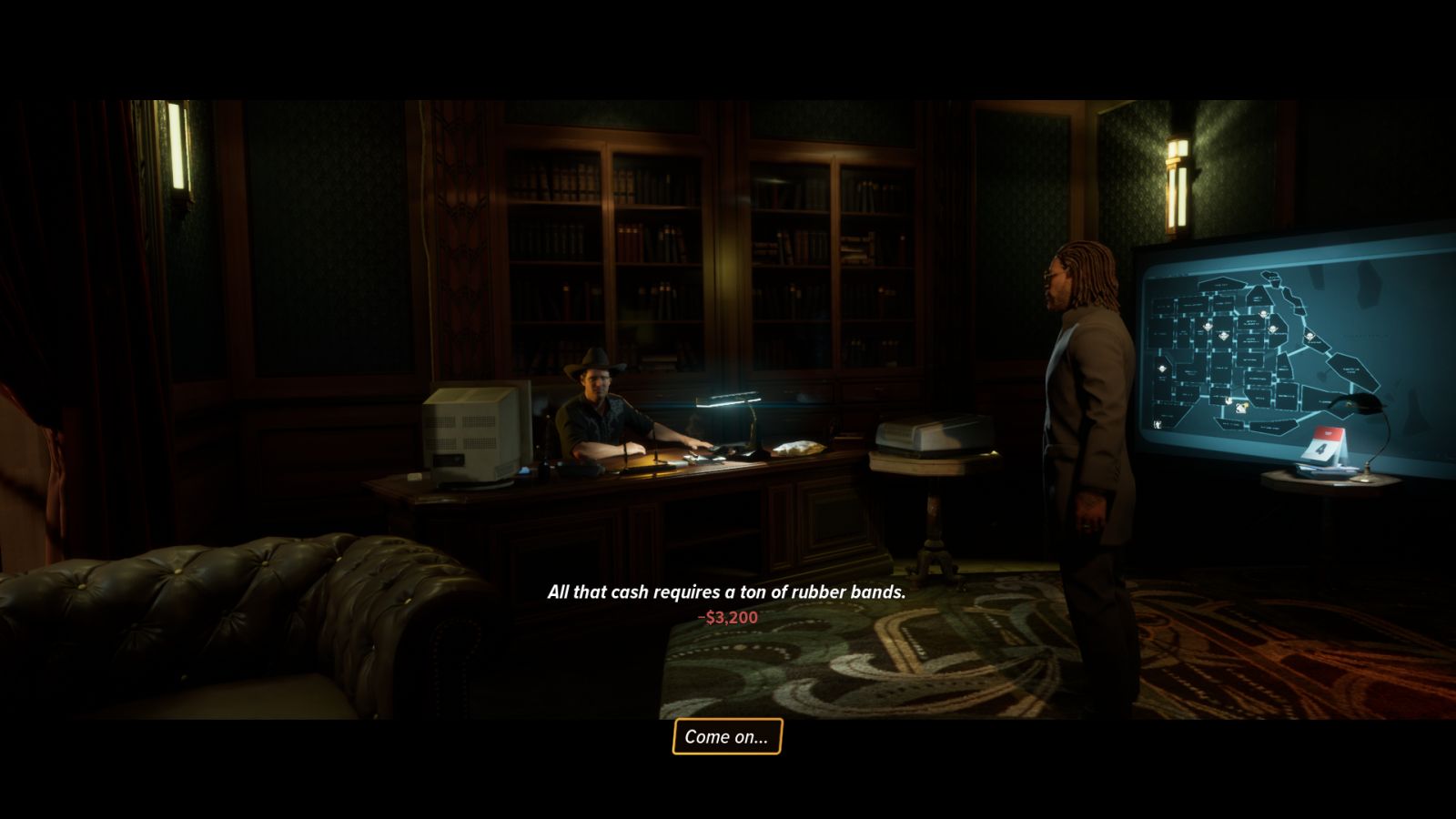
After a heist, the goods you stole go to your stash, where you can hoard them, or sell them on the black market. Each commodity has its own value which will fluctuate over time. Steal low, sell high! It adds another layer to heisting beyond just grabbing stuff. Let’s say the cops have arrived, and you don’t want to risk dealing with them, will you grab the expensive wine, or the electronics? Which one has the higher value currently? It always feels satisfying to sell your stash when the price is higher, and have a big, new chunk of money to fund your operations.
On top of that, maybe someone you need to make a deal with enjoys indulging in cocaine, so give them some of the drugs in your stash instead of paying a hefty sum of cash. It’s a really cool system, and it’s not used NEARLY enough, but I suppose that describes this game in a nutshell. They could have had a hacker who you can give electronics to who will slow Norris’s investigation progress, or a winery who you give your alcohol to poison enemies, thus giving them lower health. There was so much potential in this system, but they only used it for one of the goods in your stash.
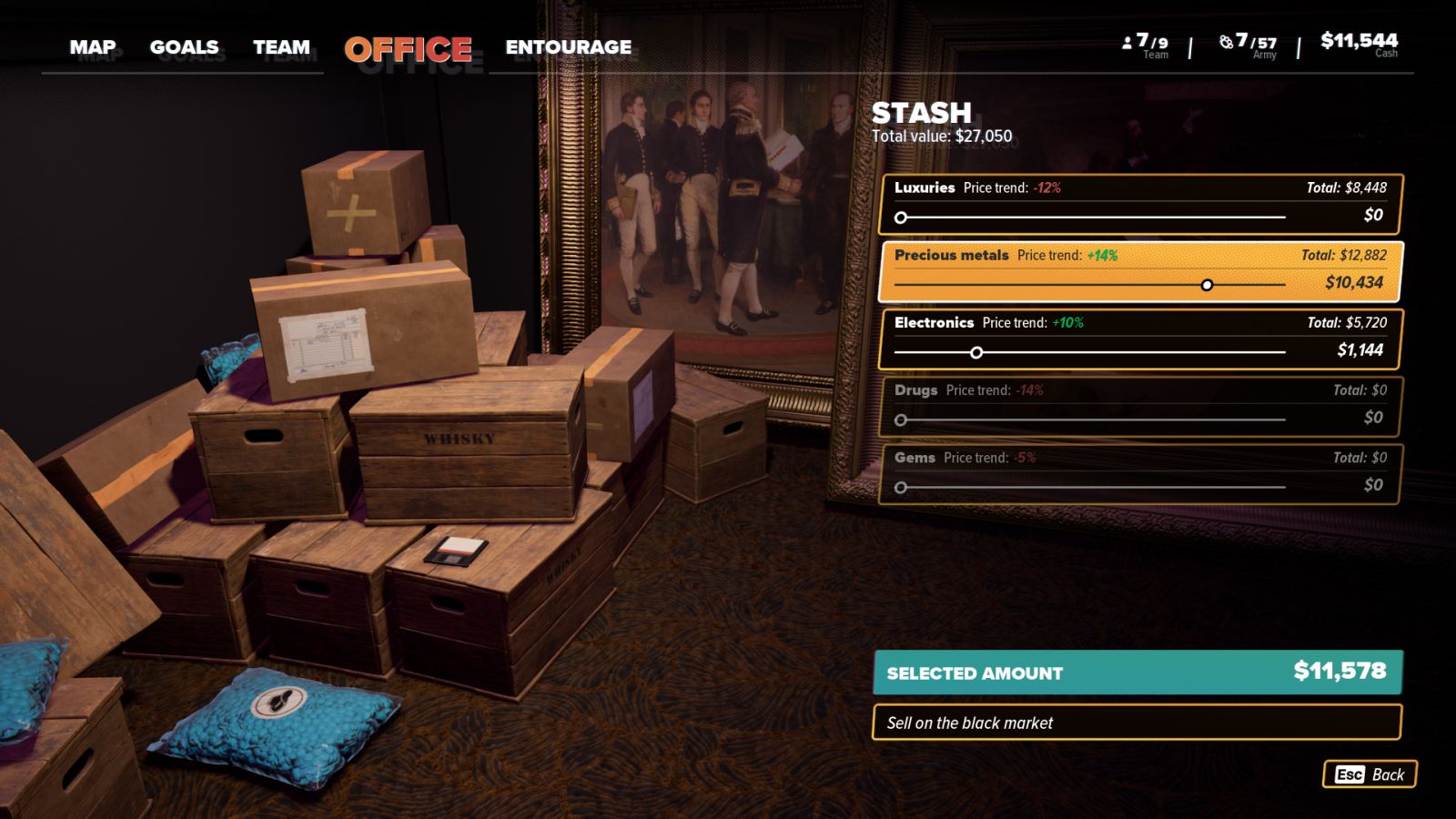
Enemy gangs can attack your warehouse and take your stash, these missions can be challenging if you have a poorly prepared crew. Luckily, you can promote your crew over time, thus giving them better stats. However, sometimes it’s better to just periodically sell off your goods and just let the gangs raid the warehouse, because you’re forced to have Baker on warehouse defense missions, and if he dies, the run is over.
There are four other gangs competing for turf, The Riders, The Sicarios, The Chicos, and The Scudos. They all have different leaders and behaviors. The Riders are aggressive expansionists, and will be attacking your territory often. The Scudos are the opposite, tending to keep to themselves, with highly defended territories. The Sicarios wont go out of their way to attack you, but they don’t take nonsense, and the Chicos will seemingly always start hostile to you. It’s worth noting that you can track which gang is feuding with who, but I’ve rarely actually seen them fight each other. They mostly just the player, which is another unfortunate waste of a neat system. You also can’t ally with any other gangsters. My suggestion is to take out The Chico’s first, then move onto The Riders, they’ll be the most hostile.
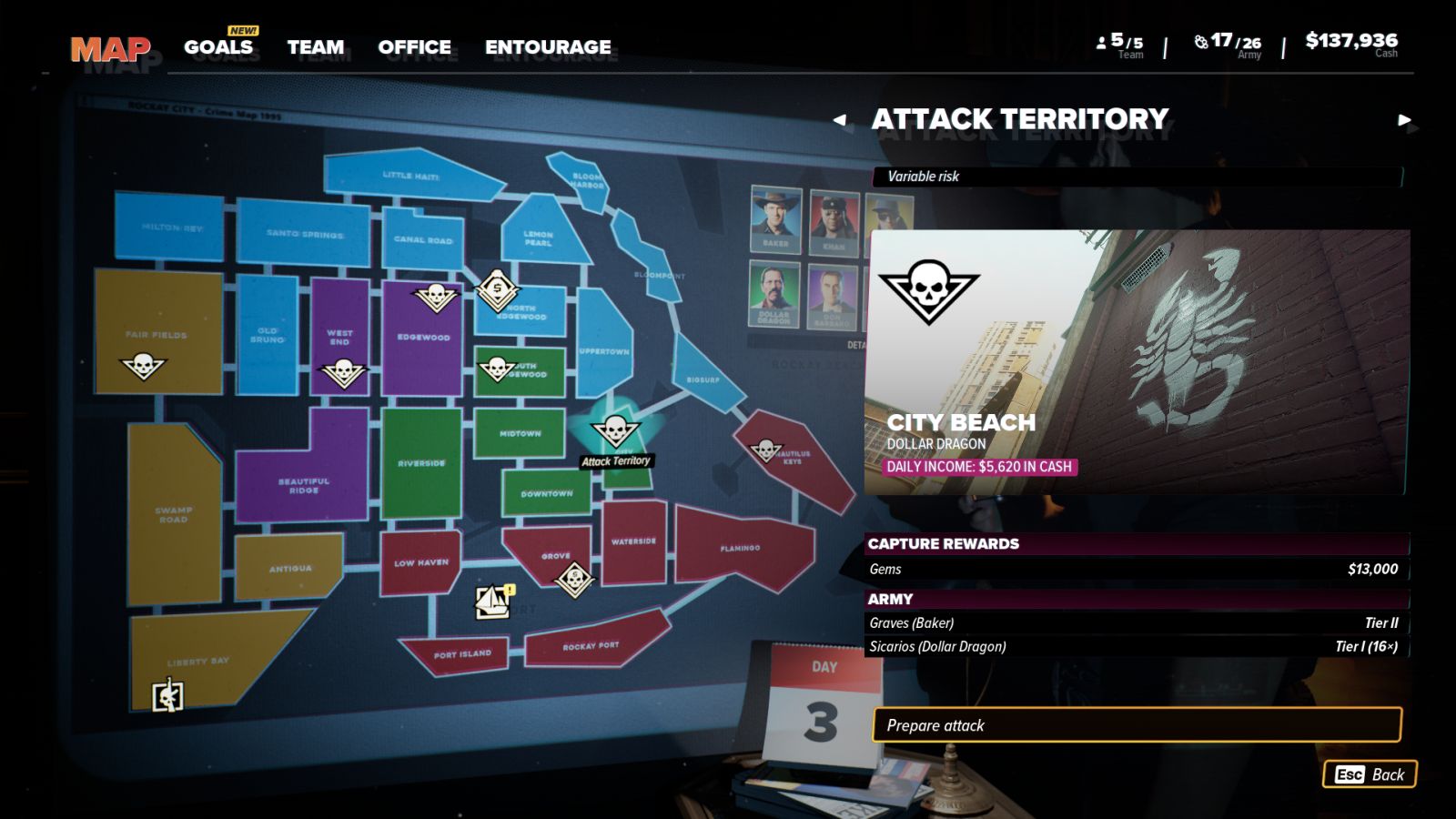
The turf map is divided into territories which you can capture. Attacking requires both soldiers and money. The battles for turf consist of short fights against numerous gangsters in a two phase fight. Phase one is to eliminate normal gangsters, and phase two requires you to kill their captain who, in a nice convenience feature, is always highlighted in red. You get to choose how many soldiers you send into battle, but the more you send in, the higher the cost of the fight. Much like your crew members, soldiers can only perform one action per day, so growing your army is important.
The order in which you attack territories is also important, if you take the right piece of land, then it could cut off another, thus transferring it to you. That means gaining more territory, and spending less money which you could use for other turf battles. If you press a gang hard enough, they may even offer you a hefty sum of cash for a ceasefire. You can break that truce, but there are consequences for your actions.
Once you have a piece of land, you have to defend it against enemies. You’ll either play as a generic gangster, or Touchdown, who has a machine gun which is great for defense. You never have to deal with an enemy captain here, this is YOUR turf. It’s also great that the gunplay feels nice, and the gun designs look pretty sick.
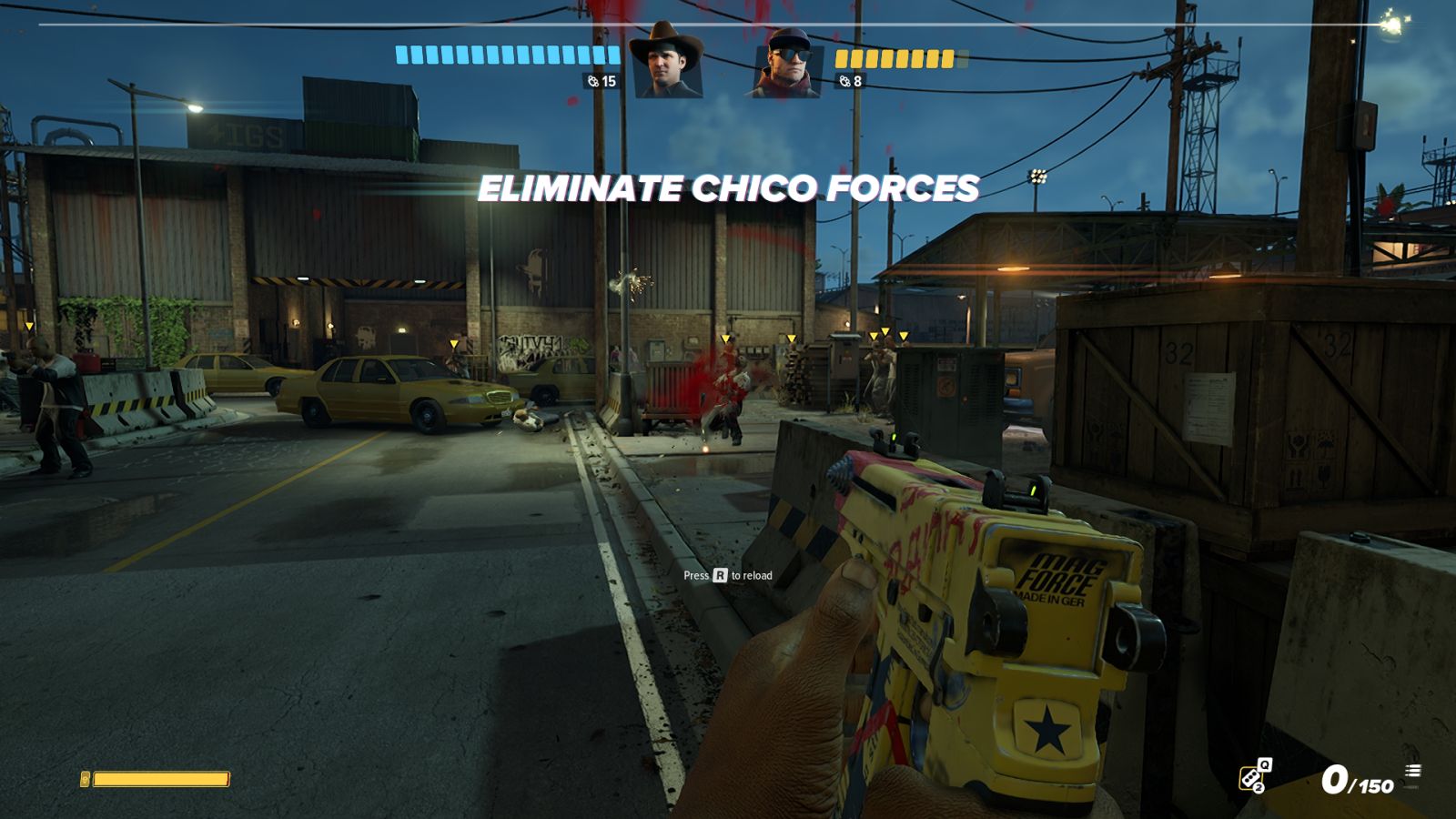
If you find that an enemy stronghold is too hard to take, you have two routes. The first is to strengthen your army by purchasing better weapons. The second is to weaken your enemy by targeting their warehouses, assassinating their officers, and causing general mayhem. However, there aren’t enough opportunities to weaken your opponent, and it’s questionable just how effective weakening them is. There are other problems with the turf war system, for example, I’ve literally spawned in a battle with enemies in front of me, shooting at me, causing me to die. Other times I witnessed enemies spawning in front of me.
To wrap up, I need to talk about the roguelike aspects in Crime Boss: Rockay City. For example, every time you increase your boss level, you gain a permanent perk, many of which stack. It might increase how many soldiers you start with, or give you a cool new weapon on the start of every run. However, it occasionally feels like the game is trying to railroad you into a loss so you have to start a new run. Enemies become much stronger over time, so stealth is essential. Having a late game mission’s stealth run (and all the preparation that went into it) ruined by a random event, or scripted explosion, or bug hurts even more. It feels like that game is telling you “Okay, this run has gone on long enough, time to start your next one so that you can feel the vertical progression, and actually use all these upgrades we worked so hard on!” On top of that, the end game is ridiculously repetitive due to the lack of map diversity. You’re basically heisting on the same few map templates over and over. It’s a massive test of your patience.

There are multiplayer modes, but they don’t add anything to the table. You’re pretty much just playing missions from the campaign but without any of the good meta progression or turf wars.
Crime Boss: Rockay City
Mediocre
Overall, Crime Boss: Rockay City offers so many conceptually interesting gameplay mechanics that could work well together, but either doesn't give the player enough opportunities to use them, or fails to tie them into other aspects of the game. There is some minor depth to the game, but it's overshadowed by what could have been. On top of that, too many elements feel like they’re out of the players hands, and lead to cheap deaths. If you simply need to play Crime Boss: Rockay City, then you’ll be pleased to hear that it’s only $40, and even less if you wait for a sale.
Pros
- Cool gun designs
- Crew has competent AI
Cons
- Stealth is dubious at best
- Railroaded into losing runs
- Lack of map variety
- Repetitive late game
